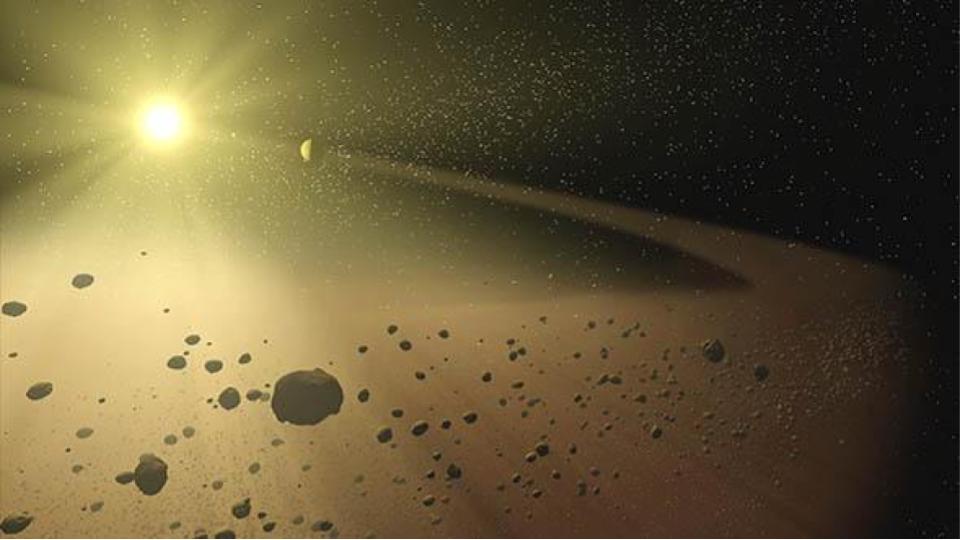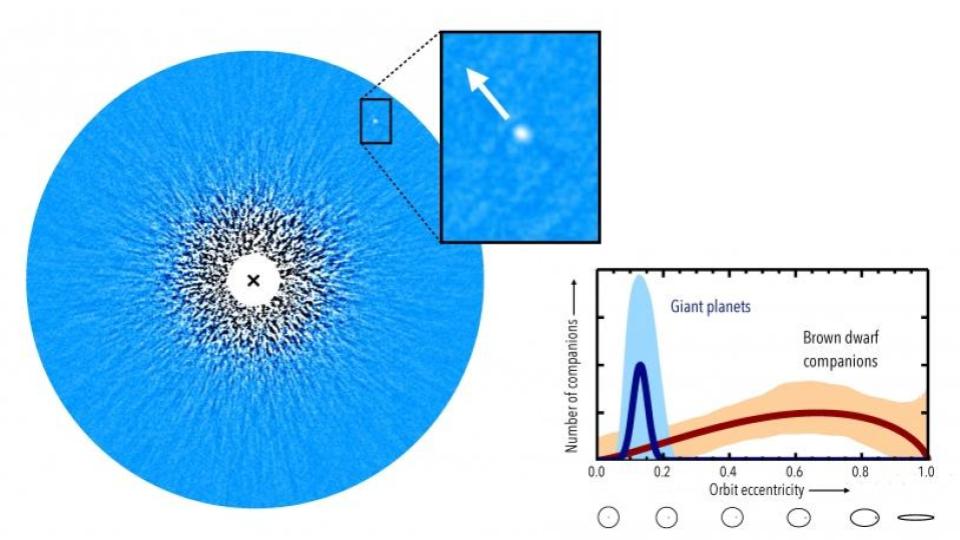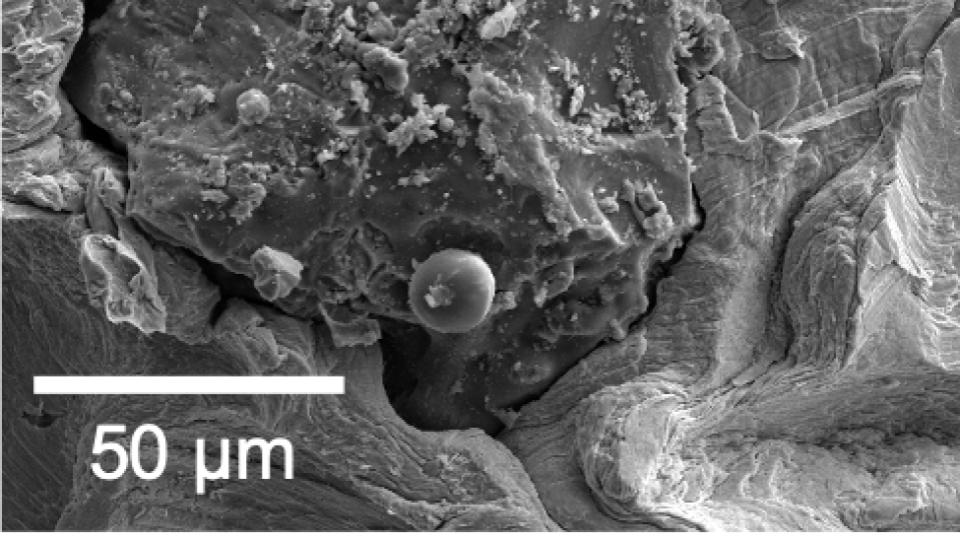Today’s show starts with a mighty YORP. It turns out the YORP effect may spin asteroids to death in dying star systems. We also look at how the formations of giant planets and brown dwarf stars differ, and a new way to get science from dust.

Today’s episode starts with news that “Supercharged light pulverizes asteroids.” Now, I’m not gonna lie. When I first saw the phrase “pulverizes asteroids” I assumed this was purely click bait. Pulverizes make me imagine breaking asteroids up into smaller and smaller pieces, and light, in general, is going to melt things, rather than break things.
But, there are exceptions, and this not-totally-click-bait title to a press release is talking about an exception that is clever and actually has a magnificent name: The YORP effect.
The YORP effect is well known in our own solar system: Sunlight hits an asteroid and due to asymmetries on the outside and inside of the asteroid, that light can set an asteroid spinning in not-entirely-predictable ways. The more light, the more spin, and, it turns out, if the light gets strong enough and the resulting spin gets fast enough, asteroids will spin themselves apart.
In new software models from the University of Warwick, astronomers have calculated how the bright light coming off an evolved giant star is sufficient to spin-up a system’s asteroids to breakup speeds. Within as little as a million years, this effect can reduce the majority of the objects in a system to just 1 to 100 meters in diameter. This work, published the Monthly Notices of Royal Astronomical Society with lead author Dimitri Veras, shows that as a star expands out to become a giant, it’s luminosity will increase by 1000 to 10000. Any asteroids that survive the star’s expansion and aren’t simply eaten, will get blasted with light, and accelerated to breakneck rotational rates of one rotation per 2 hours. At that kind of a speed, gravity isn’t enough to hold a large asteroid together – so it flies apart. Many asteroids, like Bennu and Ryugu, are just piles of rubble that will become clouds of debris. Smaller asteroids, while lacking gravity, have stronger chemical bonds holding them together, and with their smaller radii, can withstand a higher rotational rate. Objects Pluto’s size and larger – round worlds – have sufficient gravity that they should survive the YORP effect. In-between roughly 100 m and a few 1000 km, objects will go through repeated break up events until everything is shredded as small as possible.
Like all the best science – this paper makes a prediction about how white dwarf stars and advanced giant stars should have debris disks around them. These discs may actually evolve to look like Han Solo’s asteroid belt as the rocks collide and migrate in toward their white dwarf star. A lot of this debris will end up falling onto their white dwarf, polluting their atmosphere in ways that should be observable.
I really like this story – it has a great named effect – the YORP effect – it gives us Han Solo’s asteroid belt, it includes mass destruction, and it makes observable predictions. It really doesn’t get better than that,

Credit: Brendan Bowler (UT-Austin)/W. M. Keck Observatory
From the death of solar systems, we now turn to their formation. One of the most common questions we’ve seen is “what separates a failed star from a giant planet.” From the physics side, it’s easy: brown dwarf failed stars are large enough to undergo temporary nuclear burning as their insides hit temperatures and densities capable of fusing heavy hydrogen, like tritium and deuterium. What is less straightforward is determining if the formation of failed stars and planets are actually different. For instance – could we have had a star in the position of Jupiter? Will we find planetary systems with planets orbiting like Venus and Neptune in a system with a star in between? New research from the University of Texas tries to make sense of this by looking at star systems with brown dwarfs to see if they can observationally sort an answer.
Using the Keck and Subaru telescopes in Hawaii, a team led by Brendan Bowler looked at 27 systems with a brown dwarf or giant planet and a regular star, and they observed how the smaller object orbited the normal star over years. While this wasn’t enough information to precisely measure orbits, it was enough to constrain what kinds of orbits were possible. This was good enough to see that while the giant planets had a tight distribution of mostly circular orbits, the brown dwarfs tended to have much more elliptical orbits. This difference provides our answer.
Solar systems form through the collapse of a large cloud of material. A star will form in the center, and planets will form in a disc around that center, as dust and particles collide to build larger and larger objects – eventually forming planets in mostly circular orbits. Binary stars form as two collapsing clouds that are orbiting one another, and end up in every possible orbit, and are generally not circular orbits. The new data from Bowler’s team shows that Brown Dwarf orbits’ are consistent with them forming like stars. This limits just how interesting solar systems may be, but places a nice clear boundary between stars and planets.

In a final news note, a team of planetary scientists in Chicago is testing a new way to study lunar and planetary systems on an atom by atom basis. By shaving samples off dust grains, this team is probing how water and helium formed on the moon, and getting a handle on the way dust is altered by exposure to micrometeoroids and radiation.
Doctoral Student Jennika Greer is producing remarkable images, which you can see on our website, the DailySpace.org. While there is no big science result yet, this technique has the potential to unlock new ways to do systematic science with materials previously deemed useless; for instance, this technique, called atom probe tomography, could be used to study dust that came back in the astronauts space suits, and other fine particulate that had previously been considered useless for science. This technique will also expand what science can be done with asteroid samples from Ryugu and Bennu.
And when that science is published – we’ll be here to share it with you on the Daily Space.
<———————>
And that rounds out our show for today.Thank you all for listening. The Daily Space is written by Pamela Gay, produced by Susie Murph, and is a product of the Planetary Science Institute, a 501(c)3 non profit dedicated to exploring our Solar System and beyond. We are here thanks to the generous contributions of people like you. Want to become a supporter of the show? Check us out at Patreon.com/cosmoquestx


 We record most shows live, on Twitch. Follow us today to get alerts when we go live.
We record most shows live, on Twitch. Follow us today to get alerts when we go live.